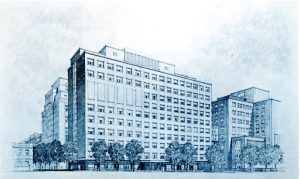Lillian K.P. Farrar, MD a Unique Woman at the Woman’s Hospital
Woman’s Hospital (1855-1952) is a unique institution in the history of American medicine, in several ways. It has claimed to be the first hospital in the world devoted exclusively to “the problems of medicine peculiar to women.” Founded by a group of well-to-do women in NYC, in conjunction with Dr. J. Marion Sims, this group formed the Women’s Hospital Association, and ran the Hospital themselves for the first several years. It was re-organized and re-chartered as the Woman’s Hospital in the State of New York in 1857, making the drastic change of introducing an all-male Board of Governors, who ran the top-level business of the organization. Considering the limits of female power in 1857 and connections in business and finance needed at that time in order to run a growing medical facility, it makes some sense. (1)
Women did, however, continue to run the majority of the daily business of the Hospital. In the 1880s several of the ‘Lady Managers’ were invited to join the Board of Governors by necessity, to fill several slots that had gone unfilled for a prolonged time. It was a successful experiment and made permanent after about a year, re-creating the Board almost equally by gender. What is a bit odd, considering the strong presence of women in the leadership, is that it took until 1918 for a woman to break into the medical end of the work. However, the woman who did it was as unique and unusual as the Hospital for which she worked.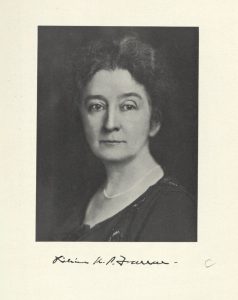 Lillian Keturah Pond Farrar was born in Newton Center, Massachusetts in December 1871 to Jefferson Clinton Farrar Jr., and Sarah D. Pond. (2) She earned her BA at Boston University, and completed her medical education at the Cornell University Medical College. Records there indicate that prior to enrolling she took medical classes at the New York Infirmary for Women and Children between 1896 and 1899. She graduated from Cornell in 1900 at age 29, and returned to the New York Infirmary to take her internship. (3) After that, she spent several years (1901-1904) training in Paris and in Vienna, visiting medical clinics in Paris, Berlin, London, Stockholm, and Rome as well, much like any male physician of that time might do. (4)
Lillian Keturah Pond Farrar was born in Newton Center, Massachusetts in December 1871 to Jefferson Clinton Farrar Jr., and Sarah D. Pond. (2) She earned her BA at Boston University, and completed her medical education at the Cornell University Medical College. Records there indicate that prior to enrolling she took medical classes at the New York Infirmary for Women and Children between 1896 and 1899. She graduated from Cornell in 1900 at age 29, and returned to the New York Infirmary to take her internship. (3) After that, she spent several years (1901-1904) training in Paris and in Vienna, visiting medical clinics in Paris, Berlin, London, Stockholm, and Rome as well, much like any male physician of that time might do. (4)
After her European training was completed, our information about Dr. Farrar jumps to 1918. That year Lilian K.P. Farrar, MD, age 47, became a Junior Attending Surgeon, the first woman physician appointed at Woman’s Hospital. She became an Attending Surgeon in 1927 and Consulting Surgeon in 1935 at age 64. (5)
Relatively unknown today, Dr. Farrar was active in the broader medical community during her working life. She was a woman of firsts: the first woman to serve as an Assistant Professor in Obstetrics and Gynecology at the Cornell University Medical College from 1918 until 1953 (ages 47- 82) and the first woman physician appointed Chief of Clinics (gynecology) there as well. She was the first woman elected as a Fellow of the American Gynecological Society in 1921, and the only woman in the Society for fifty years, as another woman wasn’t welcomed in until 1971 (6). She was the first woman to serve as a Governor of the American College of Surgeons, serving multiple terms between 1925 and 1937. Additionally, she was the first – and only – woman to be a ‘founding Diplomate’ of the American Board of Obstetrics and Gynecology (1930). Her body of articles, published between 1917 and 1937, indicate that she was an accomplished gynecological surgeon, even collaborating with a colleague on perfecting irradiation techniques for treating gynecological cancers. (7)
Outside of professional accomplishments, Farrar, who remained single throughout her life, numbered among the social elite of her time. She is listed in both the New York Social Blue Book for 1930 (8), and the Register of the National Society of Colonial Dames in the State of New York 1893-1926. (9) The Society requires members be direct descendants of someone, or in her case, ten of them, who “lived in the American colony and rendered it service before July 5, 1776.” (10) Farrar supported the Woman’s Suffrage movement and fostered the acceptance of women as interns at Bellevue Hospital, New York, in 1914 and at Woman’s Hospital in 1920. (11)
Another gap in our information about Dr. Farrar exists between 1953 and her death in the Lake Placid Memorial Hospital on June 22, 1962, attributed to arteriosclerotic heart disease (12), at the age of 90. (13) She is buried in Newton Center, Massachusetts.
Sources:
1. Annual Reports of Woman’s Hospital, 1855; 1857; 1918; 1920
2. Family Search website listing: https://ancestors.familysearch.org/en/MQQX-JLV/lillian-keturah-pond-farrar-1871-1962
3. Cornell University Medical College Students Register 1898-1907. NewYork-Presbyterian/Weill Cornell Medicine Medical Center Archives.
4. Dr. Lillian K.P. Farrar. Medical Woman’s Journal (vol. XLIII, page 190, July 1936).
5. Obituary. The Times Newsletter of Woman’s Hospital, Dec 1962, Vol 14, #2 p.11
6. “Gender Ideology in the Rise of Obstetrics.” Naoko ONO. The Japanese Journal of American Studies, No. 17 (2006)
7. Women in Medicine website: http://obgynhistory.net/miscwomandocs.html
8. NY Social Blue Book: http://bklyn-genealogy-info.stevemorse.org/Directory/Blue/1930.BlueF.html
9. Register of the National Society of Colonial Dames in the State of New York, 1893-1926 https://www.google.com/books/edition/Register_of_the_National_Society_of_Colo/TdBKAAAAYAAJ?hl=en&gbpv=1&dq=the+Register+of+the+National+Society+of+Colonial+Dames+in+the+State+of+New+York.+1893-1926&pg=PA3&printsec=frontcover
10. The National Society of Colonial Dames in the State of New York website membership inquiries page: https://www.nscdny.org/membership-inquires
11. Dr. Lillian K.P. Farrar. Medical Woman’s Journal (vol. XLIII, page 190, July 1936).
12. Unidentified clipping, from the Elizabeth Bass Collection on Women in Medicine, Rudolph Matas Medical Library, Tulane University Medical Center, LA. https://library.tulane.edu/sites/default/files/media-files/matas/matas_collections_bassindex2014_01.pdf
13. Obituary. The Times Newsletter of Woman’s Hospital, Dec 1962, Vol 14, #2 p.11
Authored by Michala Biondi, Associate Archivist

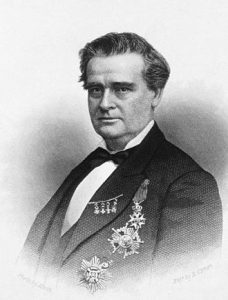 The Woman’s Hospital, often considered the first hospital in this country dedicated to treating the diseases of women,
The Woman’s Hospital, often considered the first hospital in this country dedicated to treating the diseases of women,  As mentioned above, the first Woman’s Hospital was a rented four-story brownstone at 83 Madison Avenue, off 29th Street, pictured left. The brownstone held forty beds and welcomed its first patient in May of 1855. The response to the Hospital’s opening was so great, by fall of 1855 that another surgeon,
As mentioned above, the first Woman’s Hospital was a rented four-story brownstone at 83 Madison Avenue, off 29th Street, pictured left. The brownstone held forty beds and welcomed its first patient in May of 1855. The response to the Hospital’s opening was so great, by fall of 1855 that another surgeon, 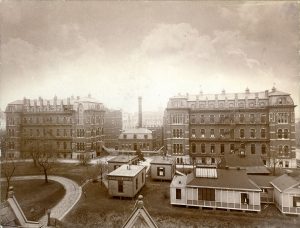 Over the years, the Board recognized the need to develop additional services. A post-graduate school of nursing admitted its first class in 1888. The establishment of a hospital pharmacy in 1881, a maternity ward in 1910, and a social services department in 1912 are examples of the additional services made available at Woman’s Hospital.
Over the years, the Board recognized the need to develop additional services. A post-graduate school of nursing admitted its first class in 1888. The establishment of a hospital pharmacy in 1881, a maternity ward in 1910, and a social services department in 1912 are examples of the additional services made available at Woman’s Hospital.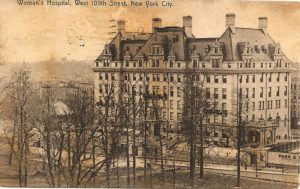 Hospital services resumed in 1906, when a newly constructed Woman’s Hospital opened on West 109th Street, between Amsterdam and Columbus Avenues, pictured left. The hospital functioned here until 1965, when it moved just a few blocks north into a newly constructed building on the
Hospital services resumed in 1906, when a newly constructed Woman’s Hospital opened on West 109th Street, between Amsterdam and Columbus Avenues, pictured left. The hospital functioned here until 1965, when it moved just a few blocks north into a newly constructed building on the 